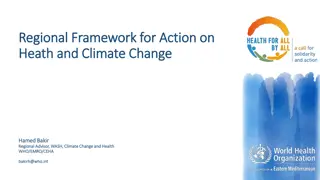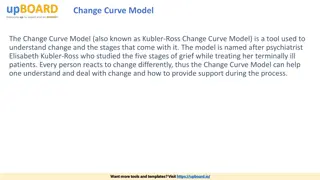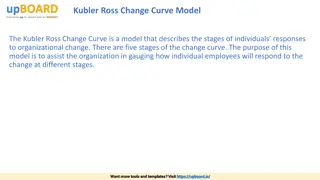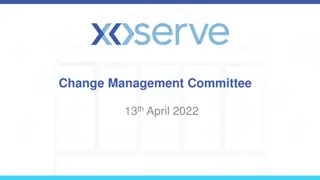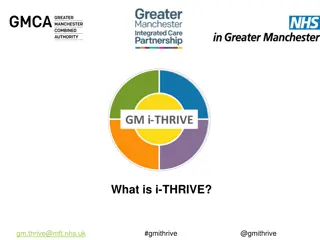Understanding the THRIVE Framework for System Change
The THRIVE Framework, developed in collaboration by the Anna Freud National Centre for Children and Families and the Tavistock and Portman NHS Foundation Trust, focuses on a needs-led approach, shared decision-making, and proactive prevention in supporting mental health and well-being for children and young people. It emphasizes common language, explicit definition of needs, and addressing the distinct needs of individuals through five groups: Thriving, Getting Advice, Getting Help, Getting More Help, and Getting Risk Support.
Download Presentation

Please find below an Image/Link to download the presentation.
The content on the website is provided AS IS for your information and personal use only. It may not be sold, licensed, or shared on other websites without obtaining consent from the author. Download presentation by click this link. If you encounter any issues during the download, it is possible that the publisher has removed the file from their server.
E N D
Presentation Transcript
Implementing the THRIVE Framework Phase 1: Developing a full understanding of your current system If we keep on doing what we have been doing, we are going to keep on getting what we have been getting 1
Our Presentation Today 1. Overview of the THRIVE Framework and Implementing THRIVE (i-THRIVE) 2. Recap of work already undertaken 3. Thinking about redesign 4. Top level actions to take forward 2
Overview of the THRIVE Framework for system change (Wolpert et al., 2019) 3
The THRIVE Framework for system change The THRIVE Framework for system change (Wolpert, et al. 2019) was developed as a collaboration between the Anna Freud National Centre for Children and Families and the Tavistock and Portman NHS Foundation Trust. Built on learning from: Child Outcomes Research Consortium (CORC); use of patient reported outcome measures to transform practice: www.corc.uk.net Choice and Partnership Approach (CAPA); how to manage flow and embed shared decision making: http://capa.co.uk/ Payment Systems in CAMHS development; 19 case mix adjusted groupings: http://pbrcamhs.org/final-report-published/ 4
The THRIVE Conceptual Framework Input offered Description of the THRIVE groups Distinction between advice/support and evidence based treatment The five needs based groups are distinct in terms of the: o needs and/or choices of the individuals within each group o skill mix of professionals required to meet these needs o resources required to meet the needs and/or choices of people in that group THRIVE Framework for system change (Wolpert et al., 2019) 5
THRIVE Framework Key Principles Common Language Common conceptual framework (five needs-based groupings: Thriving, Getting Advice, Getting Help, Getting More Help, Getting Risk Support) shared across all target groups. Needs-Led Approach based on meeting need, not diagnosis or severity. Explicit about the definition of need (at any one point, what the plan is and everyone s role within that plan). Fundamental to this is a common understanding of the definitions of needs- based groupings across the local system. Shared Decision Making Voice of children, young people and families is central. Shared decision-making processes are core to the selection of the needs-based groupings for a given child or young person. Proactive Prevention and Promotion Enabling the whole community in supporting mental health and wellbeing. Proactively working with the most vulnerable groups. Particular emphasis on how to help children, young people and their communities build on their own strengths including safety planning where relevant. 6
THRIVE Framework Key Principles Continued Partnership Working Effective cross-sector working, with shared responsibility, accountability, and mutual respect based on the five needs-led groupings. Outcome-Informed Clarity and transparency from outset about children and young people s goals, measurement of progress movement and action plans, with explicit discussions if goals are not achieved. o Discuss the limits and ending of interventions o Differentiate treatment and risk management o Consider full range of options including self or community approaches. Reducing Stigma Ensuring mental health and wellbeing is everyone s business including all target groups. Accessibility Advice, help and risk support available in a timely way for the child, young person or family, where they are and in their community 7
What does the THRIVE Framework mean to young people? No wrongdoor , meaning anyone they went to see for advice, whether they were a teacher, a GP or the school lunchtime assistant, would be able to provide support or to signpost a child. Whoever is offering them help would know the best ways to ask for their views about what was important to them and what they wanted to be different, so that there is genuine shared decision making about ways of helping. There will be a particular emphasis on looking at different things the young person, their family and friends could do to help including accessing community groups and resources, from drama, to sport, to volunteering. 8
Continued Whoever is providing targeted specific help to address the mental health difficulties would support the young person to evaluate progress and to check that what was being tried was helping. There will be supportive but transparent conversations about what different treatments were likely to lead to, including the limitations of treatment and the possibilities of needing to put in place management of ongoing difficulties as relevant. 9
Implementing THRIVE (i-THRIVE) The THRIVE Framework, in the words of Benjamin Zander is: A possibility to live into 10
The response to the THRIVE Conceptual Framework We really like the concept and principles of the THRIVE Framework and would like to use it to underpin our redesign of mental health services for children and young people in line with Future in Mind BUT What do the principles look like in practice on the ground? How do we make it work in our area? Is there a blueprint for implementation? How should we design services to reflect THRIVE principles? How do we implement the concepts? Can we access support for implementation? 11
National i-THRIVE Programme i-THRIVE is the implementation programme that supports sites to translate the THRIVE Conceptual Framework into a model of care that fits local context. The National i-THRIVE Programme is a collaboration between the Anna Freud National Centre for Children and Families, the Tavistock and Portman NHS Foundation Trust, Dartmouth Institute for Health Policy and Clinical Practice, and 12 UCLPartners.
i-THRIVE Community of Practice: Offer Co-ordination by i-THRIVE Programme Team: Support sites to self- organise and manage i-THRIVE Academy: Learning and development support and training modules for sites Funded projects: Individual projects, e.g., Inpatient Forum, Development of local CoP s, e.g., Greater Manchester, Northern Ireland, South West England Free access to resources: Continually evolving i-THRIVE Toolkit, evidence based tools to aid implementation Membership and participation is voluntary: Promotes a bottom-up approach to service improvements, with dynamic multi- professional membership evolving over time Regular interaction: Nation-wide shared learning events, a forum for sites to share experiences about implementing THRIVE, peer support, E-newsletters Direct support to sites: From the national programme team: Includes regular liaison, coaching, consultation and practical support i-THRIVE Illustrated: Series of co-designed case studies highlighting how sites have approached implementing the THRIVE Framework 13
Core principles and components of the i-THRIVE model of care 14
i-THRIVE Approach to Implementation: whole system change 16
i-THRIVE Approach to Implementation Phase 1: Understanding Your System 18
Phase 1: Understanding Your System and Agreeing Your Priorities 1. Establishing a team who will oversee this process Senior oversight, includes commissioners and providers of health, care and education. 2. Initial engagement with the system Communication and engagement across the system, from senior leadership to team leads and those working with children and young people day to day. Aim for agreement from the system, to increase awareness of issues as well as understanding of the possible approaches to improvement. 3. Analysis of your existing systems i. Pathway Mapping ii. Data Analysis iii. Qualitative Understanding 4. THRIVE Framework Baseline: How THRIVE-like are we currently? 5. Agreeing priorities for improvement i. What are our collective aims? ii. What are the priority areas that will help us improve on these areas? 6. Transformation Design and Implementation Planning 20
i-THRIVE Approach to Implementation Phase 1: Understanding Your System Mapping Your Pathways If we keep on doing what we have been doing, we are going to keep on getting what we have been getting 21
Mapping Your Pathways: work completed At the last two workshops we: Defined the scope of our pathway Built our pathway Reviewed the pathway as a group Analysed the pathway from four different perspectives: 1. Service user experience 2. Operations (interactions between services and agencies) 3. Evidenced based interventions 4. Outcomes and measures Highlighted areas of good practice, problems with quality and problems with duplication and inefficiency Reviewed the pathway as a group again Added in additional agencies that had previously been missed Identified areas that needed further work or a deep dive 22
Mapped Pathway [enter picture of mapped pathway] 23
i-THRIVE Approach to Implementation Phase 1: Understanding Your System Data Analysis If we keep on doing what we have been doing, we are going to keep on getting what we have been getting 24
System Data Analysis: Quantitative [enter overview of quantitative data from review of the system] 25
System Data Analysis: Qualitative [enter overview of qualitative data from review of the system] 26
i-THRIVE Approach to Implementation Phase 1: Understanding Your System THRIVE Assessment Tool How THRIVE-like is your current system? If we keep on doing what we have been doing, we are going to keep on getting what we have been getting 27
THRIVE Framework Assessment Tool [enter scores from THRIVE Assessment Tool (macro)] 28
THRIVE Framework Assessment Tool [enter scores from THRIVE Assessment Tool (meso)] 29
THRIVE Framework Assessment Tool [enter scores from THRIVE Assessment Tool (micro)] 30
i-THRIVE Approach to Implementation Phase 1: Understanding Your System Establishing Priorities If we keep on doing what we have been doing, we are going to keep on getting what we have been getting 31
Agreed Top Five Priorities 1. [enter priority] 2. [enter priority] 3. [enter priority] 4. [enter priority] 5. [enter priority] 32
i-THRIVE Approach to Implementation Phase 1: Understanding Your System Gap Analysis If we keep on doing what we have been doing, we are going to keep on getting what we have been getting 33
Gap Analysis [enter overview of information captured during the gap analysis exercise] 34
i-THRIVE Approach to Implementation Phase 1: Understanding Your System Review of Agreed Priorities If we keep on doing what we have been doing, we are going to keep on getting what we have been getting 35
Agreed Top Five Priorities Now that you have had time to think about the priorities and review the work already undertaken throughout Phase One of the i-THRIVE Approach to Implementation, does anyone feel strongly that the proposed top priorities should be changed? 1. [enter priority] 2. [enter priority] 3. [enter priority] 4. [enter priority] 5. [enter priority] Discuss as a group for 30 minutes 36
i-THRIVE Approach to Implementation Phase 1: Understanding Your System Redesign If we keep on doing what we have been doing, we are going to keep on getting what we have been getting 37
Thinking about redesign Successful implementation of the principles of the THRIVE Framework will deliver a fully integrated system of care that leads to: improvement in person centered care improvement in population level outcomes increased access to care service efficiencies Delivering the THRIVE Framework s integrated system of care requires consideration of the systems being redesigned in four broad categories: 1. how practitioners work differently from day to day with each other and children and families 2. how services and pathways are organised in order to enable needs based care (the five needs based groupings) 3. how governance and accountability is addressed and the role of leadership to enable new working practices 4. how these systems are commissioned, contracted and paid for 38
What can we learn from other areas? NHS Vanguards and New Models of Care: New Models of Care programme at NHSEngland is committed to enabling providers and commissioners to tackle historical barriers to implementation of whole system, integrated approaches such as the THRIVE Framework. Furthermore, there is a wealth of learning to be drawn from these New Care Models , or Vanguards to support the development of our THRIVE-like systems, and ensure that innovations are aligned with NHSEngland s vision of care delivery. These new models are working to develop new approaches to bringing together health services within a locality with the aim of improving population health outcomes and delivering service efficiencies. Their aim is to understand and tackle regulatory barriers, funding problems, address issues around accountability and governance, as well as support commissioners to develop novel approaches to contracting and payment. 39
Which aspects are relevant to implementing the THRIVE Framework? Developing whole system, integrated care models (place based care) has required innovation in the following domains: Creating new partnerships between provider organisations, including primary care, specialist health providers, local authority providers and providers of other statutory services (e.g. schools/ care homes / ambulance services etc.) The governance and organisational changes needed to support the new systems: Providers are starting to put in place more formal governance systems and partnerships so that they can work together more effectively, in particular facilitating pro-active approaches to risk Developing new approaches to budget management and joint commissioning Commissioners are considering how to contract for these new models of care and, in many cases, how to work with other commissioners in so doing 40
What are these new models trying to achieve that are consistent with the principles of the THRIVE Framework? Providing services in a different way to better meet needs, improve outcomes and reduce costs Strengthening prevention and early intervention Pro-active care for high risk groups More intense support for those with higher levels of need Who does what Changing roles of health and social care professionals eg how to make more effective use of GPs, nurses and other professionals in community based multi-disciplinary teams Changing where care is delivered Care being delivered in more appropriate settings, e.g. close to home, in community or other providers (schools, GPs, care homes etc.) Improving co-ordination across services by overcoming institutional barriers How different services work better together Appropriate sequencing of interventions Better manage transition Plan capacity 41
Key issues to keep in mind when thinking about redesign in [enter name place] 1. Providing services in a different way to better meet needs, improve outcomes and reduce costs 2. Who does what 3. Changing where care is delivered 4. Improving co-ordination across services by overcoming institutional barriers 42
Plans for redesign Keep in mind the work that we have done over the past couple of months in our workshops We are going to carry out a dream, design, do exercise and then really focus on the do by setting action points for the next six months Group Exercise In your group take a new piece of flip chart paper and divide it into four columns As a whole group, decide on [enter number of tables] of the top five priorities to focus on Each table can then chose one of the [enter number of tables] priorities to work on 43
Plans for redesign 30 minutes Populate the first two columns with the following information: Dream Design What would the ultimate dream be? What should it look like? Consider how young people would view it, what the organisational structure would be, what partnerships would need to be in place, staffing, location of service, modes of delivery This should be the priority that you have agreed to focus on feel free to add more information about your vision for [enter place name] in relation to the priority 44
Plans for redesign 30 minutes Populate the second two columns with the following information: Do Who What are the action points that could be undertaken in the next six months in order to progress towards what you have outlined in the design column? Who should complete the action point? Each action point should have a listed responsible person. Remember to put a completion date next to each action point! 45
Plans for redesign: feedback 30 minutes Feedback to the group the action points that you have agreed on to take implementing the THRIVE Framework forward in [enter name place] Are they any additional points from the other table? Agree finalised action points 46
Next Steps If we keep on doing what we have been doing, we are going to keep on getting what we have been getting 47
Next steps Action points typed up and sent out to the group Six month review organised Discussion on plans for wider engagement and sharing of future steps Plans for further work on understanding the system 48
For more information: i-THRIVE www.implementingthrive.org Sign up to the National i-THRIVE Community of Practice and receive monthly newsletters. Email Bethan Morris at: bmorris@tavi-port.nhs.uk @iTHRIVEinfo 49














